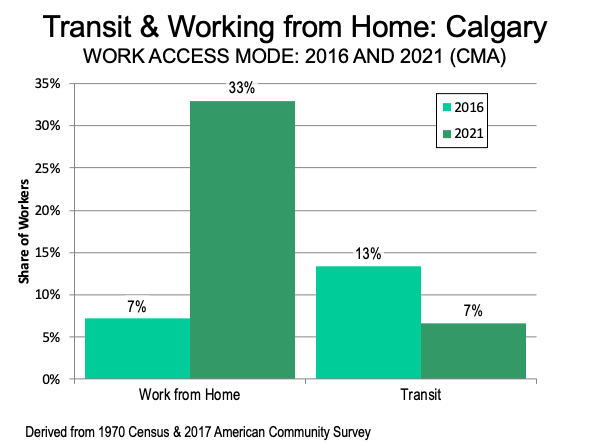
In a previous post, I commented on the difficulties faced by the Calgary CBD (downtown), with its huge office vacancies resulting from the mid-decade oil bust, along with the rise of remote and hybrid working accelerated by the pandemic.
Calgary (metropolitan area population 1.4 million) has built the largest post-World War II CBD in North America, reaching slightly more office space than the Philadelphia, with the sixth largest CBD in the United States, in a metropolitan area with four times the population.
Calgary’s Shrinking CBD
Despite its inventory of newer buildings and general attractiveness, the Calgary CBD has lost a substantial amount of its employment, starting with a virtual depression in its oil sands headquarters. Then, starting during the pandemic, fewer people commuted downtown, with the substantial increase in as from remote and hybrid work.
The Calgary CBD vacancy numbers are depressing for those of us who enjoy vibrant downtowns. A report to the City Council Executive Committee from the Planning and Development Services Department notes that since 2015, CBD property values have dropped $16.4 billion. This is a reduction in office building value of 67%. This has reduced city revenues and the lost tax base has been redistributed to commercial and residential properties outside the CBD.
The Downtown Calgary Incentive Program
Things are so desperate that the City has adopted an aggressive program to reduce downtown’s office footprint. With 14 million square feet vacant, the city has adopted the “Downtown Calgary Incentive Program,” a goal of which is to reduce CBD office space by 6 million square feet by 2021. The purpose of the program is to encourage the removal of vacant office space in the downtown to help address vacancy rates and stabilize property values over the next decade.
Adaptive Reuse: Housing and the Academy
The original and largest element of the program is “adaptive reuse” of office space to housing. Adaptive reuse has been used in many CBDs, such as Lower Manhattan, where much of the Woolworth Building, once the tallest in the world, is being converted to residential. New York mayor Eric Adams has proposed a program to convert 136 million square feet of office space to 40,000 housing units over the next decade. In downtown Los Angeles, 12,000 housing units have been created through adaptive reuse since 2000, according to a Rand report, which finds considerable potential for additional development. The Los Angeles Conservancy indicates that the downtown resident population has risen from 18,000 in 2000 to nearly 80,000 in 2020.
Having worked in downtown Los Angeles for 15 years, within two blocks when much of the next street, Broadway, along with Spring Street (the former “Wall Street of the West) and Main Street an over-supply of empty pre-World War II office buildings, I have developed a strong admiration of adaptive re-use. In Los Angeles, even some of the much later buildings from the 1950s and 1960s have also become residential. Many of the converted buildings that are pictured on this website. I often wondered what would be their fates would be and at the time, as continued emptiness and eventual demolition seemed likely.
Perhaps the ultimate adaptive re-use project is the Battersea Power Station in London. Adaptive re-use is a public policy that appears to have worked magnificently.
The city of Calgary is considering proposals that would convert up to 14 buildings to residential, adding over 2,000 housing units and reducing empty office space by two million square feet.
The city has also added a “Post-Secondary Institution Program,” which started with an agreement for the University of Calgary School of Architecture, Planning and Landscape to occupy former office space downtown. This program is being made available to other college and university programs.
The Downtown Office Demolition Incentive Program
Perhaps the most interesting, yet the smallest element is the newly added the “Downtown Office Demolition Incentive Program,” to remove 200.000 square feet of “inefficient and end-of-life buildings that negatively impact downtown vibrancy.”
Calgary is not alone in its excess inventory of CBD office space and its adaptive re-use and even demolition could represent a cautionary tale for the many other CBDs. This includes Huge CBDs in metros like San Francisco, Portland, Seattle, Chicago, Washington, and New York in the US and in Melbourne, Sydney and Toronto elsewhere.
I would not be surprised if recovery for CBDs in metros like these, and Calgary, will be very difficult.
In the United States and Canada, the previously strong transit work trip market shares to the largest CBDs seem to be dropping, not only because of the increased popularity of remote and hybrid work. Rising transit crime is being cited as a material disincentive to ride, such as in Toronto, Seattle, Minneapolis-St. Paul, Portland, San Francisco and others.
CBDs and Transit
A recent article in the San Francisco Chronicle notes that the Los Angeles metropolitan area has had a faster recovery in ridership than the previously more transit oriented San Francisco metropolitan area.This is hardly a surprise, since large CBDs dominate commuting. Nearly 60% of all workplaces reached by transit commuters in the US are in the seven core municipalities with the largest CBDs, according to ACS 2019 data (the cities of New York, Chicago, Philadelphia, San Francisco, Boston, Washington, and Seattle [not the metropolitan areas]).
Downtown is the only place that transit can provide service that is remotely competitive to the auto (in access and speed) from throughout the labor market (metropolitan area). Transit is about downtown. Before the pandemic, San Francisco had a far stronger CBD than Los Angeles and a far stronger CBD transit work trip share, which we estimated at 56%, compared to 23% in Los Angeles. In 2019, there were about 453,000 transit commuters in the San Francisco metro, about 50% more than the 307,000 in Los Angeles. In 2019, these transit commuters in San Francisco had median earnings three times that of their counterparts in Los Angeles.
Even so, Los Angeles appears to have lost much of its more limited number of affluent riders. A Los Angeles Metro (subway) operator told the Los Angeles Times: “We don’t even see any businesspeople anymore. We don’t see anybody going to Universal. It’s just people who have no other choice [than] to ride the system.”
The Challenge for Calgary
In the Calgary metropolitan area (CMA), the number of work trips on transit dropped by more than 50% between the 2016 and 2021 censuses, while the number of people working at home nearly quadrupled. In 2016, transit accounted for nearly twice as much job access as working from home. By 2021, working from home was nearly five times that of transit (Figure). Because of the differing environments between 2016 and 2021, this may not be a valid comparison. But it does indicate that the potential for working from home is very high.

The key point here is that CBDs, whether in Calgary, Toronto or New York, face incredible challenges. Further, with advances in artificial intelligence, hybrid and remote working could well make downtowns less competitive than even now, at least as places for business. Residential growth may remain the biggest hope.
Wendell Cox is principal of Demographia, an international public policy firm located in the St. Louis metropolitan area. He is a founding senior fellow at the Urban Reform Institute, Houston, a Senior Fellow with the Frontier Centre for Public Policy in Winnipeg and a member of the Advisory Board of the Center for Demographics and Policy at Chapman University in Orange, California. He has served as a visiting professor at the Conservatoire National des Arts et Metiers in Paris. His principal interests are economics, poverty alleviation, demographics, urban policy and transport. He is co-author of the annual Demographia International Housing Affordability Survey and author of Demographia World Urban Areas.
Mayor Tom Bradley appointed him to three terms on the Los Angeles County Transportation Commission (1977-1985) and Speaker of the House Newt Gingrich appointed him to the Amtrak Reform Council, to complete the unexpired term of New Jersey Governor Christine Todd Whitman (1999-2002). He is author of War on the Dream: How Anti-Sprawl Policy Threatens the Quality of Life and Toward More Prosperous Cities: A Framing Essay on Urban Areas, Transport, Planning and the Dimensions of Sustainability.
Photo: Calgary CBD, by author












